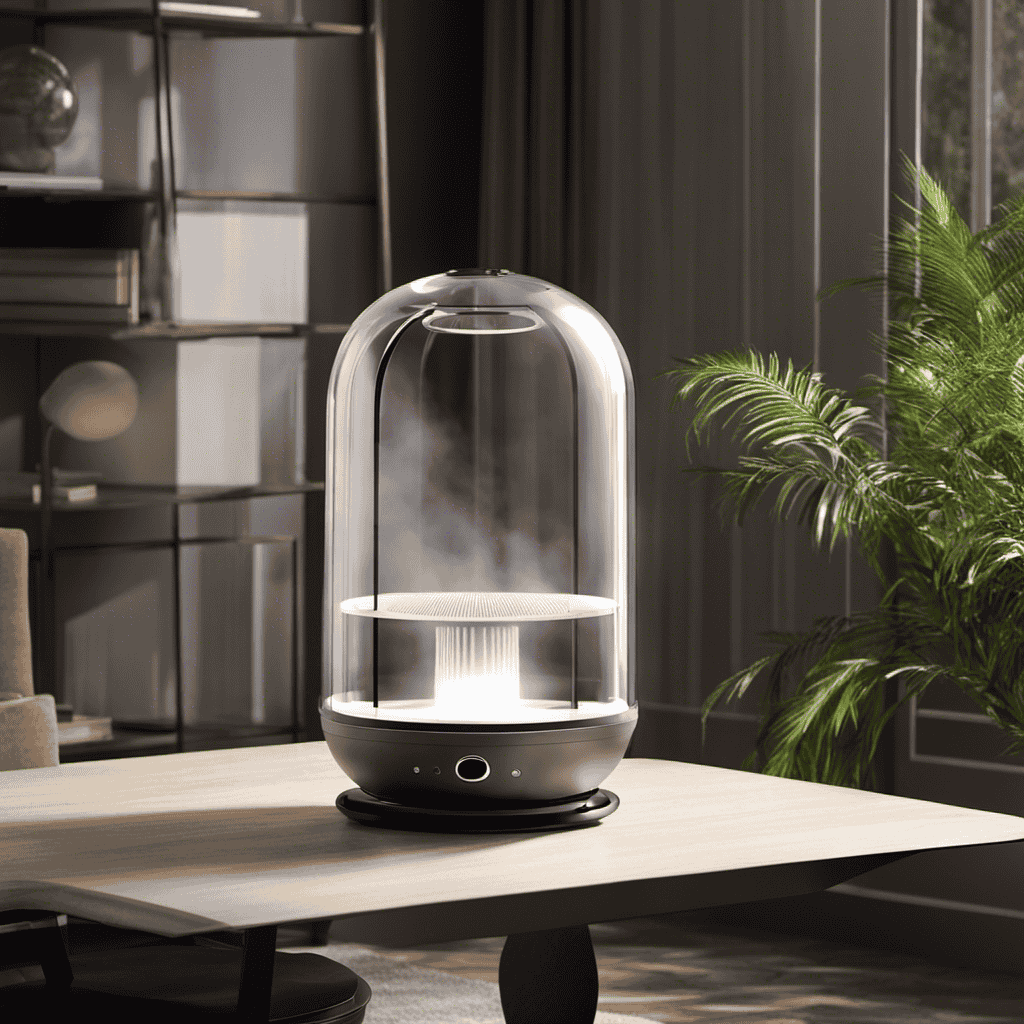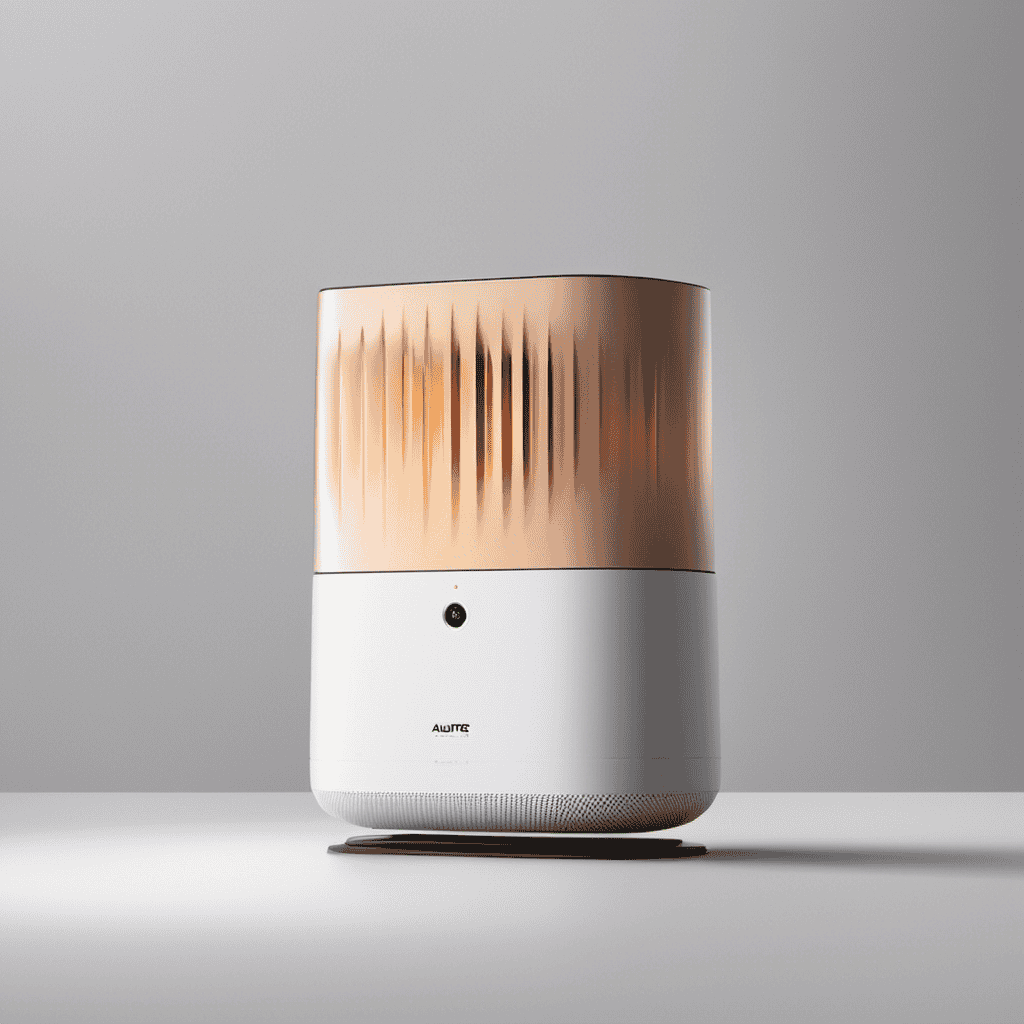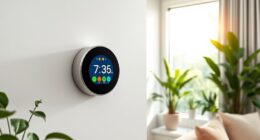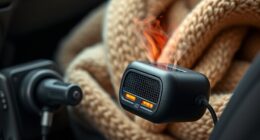I am always looking for new ways to enhance the quality of the air in my indoor space, so when I learned about UV air purifiers, I was immediately interested.
The mention of UV immediately evokes a sense of power and effectiveness in eliminating airborne germs. In this article, we will delve into the science behind UV on air purifiers, exploring its benefits and how it can significantly enhance indoor air quality.
Key Takeaways
- UV-C light emitted by lamps disrupts the genetic material of microorganisms, rendering them unable to replicate.
- Scientific studies have proven the effectiveness of UV-C light against pathogens, reducing the concentration of harmful pathogens in the air.
- UV-C light penetrates the cell walls of airborne germs and directly damages their DNA, preventing reproduction.
- UV treatment with UV-C light is non-toxic, environmentally friendly, and does not leave behind residue or harmful by-products.
The Science Behind UV on Air Purifiers
You might be wondering how UV on air purifiers actually works. Well, the mechanism of UV-C light is the key behind its effectiveness against viruses and bacteria.
UV-C light is a type of ultraviolet light that has a wavelength between 200 and 280 nanometers. When air passes through an air purifier equipped with UV-C lamps, the UV-C light emitted by these lamps penetrates the DNA of microorganisms, including viruses and bacteria, disrupting their genetic material. This disrupts their ability to replicate and render them inactive.
The effectiveness of UV-C light against viruses and bacteria has been well-documented in scientific studies. It is a powerful tool in reducing the concentration of harmful pathogens in the air, making UV on air purifiers a valuable addition to any indoor environment.
How UV Light Kills Airborne Germs
The mechanism of germ-killing through UV treatment is a fascinating process. When UV light is emitted by air purifiers, it penetrates the cell walls of airborne germs, damaging their DNA and preventing them from reproducing.
This powerful action effectively eliminates harmful bacteria and viruses from the air we breathe, providing numerous benefits for our health and well-being.
Mechanism of Germ-Killing
The UV light in the air purifier kills germs by disrupting their DNA. This is due to the germicidal properties of the UV-C wavelength.
When the UV light comes into contact with the DNA of airborne germs, it causes damage to their genetic material. This damage disrupts the normal functioning of the germs, preventing them from reproducing and causing harm.
The UV-C wavelength is particularly effective in killing germs because it has a shorter wavelength than UV-A and UV-B, making it more energetic. This higher energy allows the UV light to penetrate the outer structure of the germs and directly damage their DNA.
As a result, the germs are neutralized and rendered harmless. This mechanism of germ-killing through UV light is a key benefit of UV treatment in air purifiers.
In the subsequent section, we will explore the various benefits of UV treatment in more detail.
Benefits of UV Treatment
One of the benefits of UV treatment is its ability to effectively kill germs and neutralize them, preventing them from causing harm. UV-C light, with a wavelength range of 200 to 280 nanometers, has been proven to be highly effective in destroying various microorganisms, including bacteria, viruses, and mold spores.
This treatment method works by disrupting the genetic material of these harmful organisms, rendering them unable to reproduce. Unlike chemical disinfectants, UV treatment does not leave behind any residue or produce harmful by-products.
Additionally, UV-C light can reach areas that are difficult to clean manually, ensuring comprehensive disinfection. UV treatment is a non-toxic and environmentally friendly solution that can be used in a wide range of applications, such as air purifiers, water treatment systems, and surface disinfection.
Its advantages make it a valuable tool in maintaining a clean and germ-free environment.
Understanding the Role of UV-C Light in Air Purification
UV-C light is a powerful tool in the fight against airborne germs. Its germ-killing power lies in its ability to disrupt the DNA and RNA of microorganisms, rendering them unable to replicate and causing their eventual death.
However, it is important to consider safety precautions when using UV-C, as prolonged exposure can be harmful to human health.
Uv-C’s Germ-Killing Power
UV-C’s germ-killing power is evident in its ability to destroy the DNA of bacteria and viruses. This makes it a valuable tool in various applications, including air purification.
UV-C light is commonly used in air purifiers to eliminate harmful microorganisms that may be present in the air. The high-energy UV-C light damages the genetic material of these pathogens, rendering them unable to reproduce and causing their demise.
However, it is important to note that while UV-C light is effective in killing germs, proper safety measures must be followed when using it. Direct exposure to UV-C light can be harmful to humans, causing skin and eye damage.
Therefore, it is crucial to use UV-C light in a controlled and enclosed environment, ensuring that it is not directly exposed to occupants.
Safety Considerations With UV
To ensure your safety, it’s important to follow proper guidelines and precautions when using UV-C light.
UV safety is crucial due to the potential harm it can cause to the skin and eyes. When working with UV-C light, it’s essential to wear protective eyewear and clothing that covers the skin.
Additionally, avoid looking directly at the UV-C light source to prevent eye damage.
It’s also important to keep in mind that prolonged exposure to UV-C light can lead to skin burns and increase the risk of developing skin cancer. Therefore, it’s recommended to limit the time of exposure and maintain a safe distance from the UV-C light source.
Taking these precautions with UV will help ensure your safety while using this powerful germ-killing technology.
UV-C Technology: A Breakthrough in Air Purification
Using UV-C technology in air purifiers has revolutionized the way we clean and filter the air we breathe. The role of UV-C light in virus prevention is crucial, as it has been proven to effectively eliminate harmful pathogens, including viruses, bacteria, and mold. UV-C light works by damaging the DNA and RNA of these microorganisms, rendering them unable to replicate or cause infections.
This powerful germicidal effect makes UV-C technology highly effective in reducing indoor pollutants. In fact, studies have shown that air purifiers equipped with UV-C technology can eliminate up to 99.9% of airborne viruses and bacteria. Furthermore, UV-C light can also neutralize odors and volatile organic compounds (VOCs), improving the overall air quality in indoor spaces.
With its proven effectiveness, UV-C technology is a game-changer in the field of air purification, providing cleaner and healthier air for everyone.
Exploring the Benefits of UV-C Light in Air Purifiers
With its ability to eliminate harmful pathogens, UV-C light has revolutionized the way we clean and filter the air we breathe. UV-C light has been proven to effectively inactivate various microorganisms, including bacteria, viruses, and mold spores. This makes it an excellent addition to air purifiers, ensuring that the air we breathe is clean and safe. One important aspect to consider when utilizing UV-C light in air purifiers is safety. While UV-C light is highly effective in killing pathogens, it can be harmful to humans if not used properly. Therefore, it is crucial to follow safety guidelines and precautions when using UV-C light in air purifiers. Another consideration is energy consumption. UV-C light does require energy to operate, but advancements in technology have made UV-C light systems more energy-efficient, reducing their impact on overall energy consumption. By incorporating UV-C light into air purifiers, we can enjoy cleaner air while minimizing energy usage.
| UV-C Light Safety | UV-C Light and Energy Consumption |
|---|---|
| Follow guidelines and precautions to ensure safety | Advancements in technology make UV-C light systems more energy-efficient |
| Proper use of UV-C light prevents harm to humans | UV-C light reduces energy consumption in air purifiers |
| Safety measures should be implemented when using UV-C light | Energy-efficient UV-C light systems provide effective air purification |
However, there are some common misconceptions about the use of UV-C light in air purifiers that need to be addressed.
Common Misconceptions About UV on Air Purifiers
In this discussion, we will explore the effectiveness of UV light in air purification and address safety concerns associated with its use.
UV light has been widely used in air purifiers due to its ability to eliminate harmful microorganisms, such as bacteria and viruses, by disrupting their DNA.
However, it is important to consider the potential risks and precautions when using UV technology. One concern is exposure to direct UV light, which can be harmful to human skin and eyes. It is crucial to ensure that the UV light is contained within the air purifier and not directly exposed to people in the room.
Another consideration is the production of ozone. Some UV air purifiers generate ozone as a byproduct, which can be harmful when inhaled. It is important to choose a UV air purifier that does not produce excessive amounts of ozone or to use it in a well-ventilated area.
UV Effectiveness in Purification
UV is often used in air purifiers to effectively eliminate airborne contaminants. UV-C light, a specific wavelength of ultraviolet light, has been proven to be highly effective in killing viruses and other microorganisms present in the air. When UV-C light is emitted by an air purifier, it penetrates the genetic material of these pathogens, disrupting their DNA and RNA, preventing them from reproducing and rendering them inactive.
This helps to improve the overall air quality and reduce the risk of airborne infections. UV-C light has a significant impact on air purification as it targets a wide range of microorganisms, including viruses, bacteria, and mold spores. The incorporation of UV-C light technology in air purifiers has been shown to enhance their effectiveness in removing harmful airborne particles.
However, it is important to consider the safety concerns associated with UV exposure, which will be discussed in the next section.
Safety Concerns With UV
UV purifiers are becoming popular for their effectiveness in eliminating airborne pathogens. However, it is important to address safety concerns associated with UV exposure. As a user, I must take precautions to ensure my safety and the safety of others. Here are three key safety precautions to consider:
-
Proper installation: It is crucial to follow manufacturer guidelines when installing a UV purifier. This includes placing it in a location where direct human exposure is limited, such as higher up on the wall or inside the HVAC system.
-
Time and intensity control: UV purifiers should have adjustable settings for time and intensity. By setting appropriate levels, I can minimize the risk of overexposure to UV radiation.
-
Regular maintenance: Regularly cleaning and replacing UV bulbs is essential to maintain their effectiveness and prevent potential safety hazards. Following the manufacturer’s recommended maintenance schedule is crucial for optimal performance and safety.
Choosing the Right UV-C Air Purifier for Your Needs
When selecting an air purifier with UV-C technology, you’ll want to consider your specific needs and requirements. UV-C air purifiers utilize UV light technology to kill airborne pathogens and reduce allergens in the air. These purifiers work by emitting short-wavelength ultraviolet light that disrupts the DNA and RNA of microorganisms, rendering them unable to reproduce.
When choosing a UV-C air purifier, it is important to consider the size of the room you want to purify and the clean air delivery rate (CADR) of the purifier. Additionally, you should look for a purifier that has a high-quality UV-C lamp and a reliable filtration system to ensure effective purification.
It is also important to note that UV-C light can be harmful to the skin and eyes, so it is essential to follow safety guidelines and avoid direct exposure.
UV on Air Purifiers Vs. Traditional Air Purification Methods
To compare air purifiers with UV technology to traditional purification methods, it is important to evaluate their effectiveness in reducing airborne pathogens and allergens. Here are three key points to consider:
-
UV on air purifiers vs. traditional filters: UV technology in air purifiers works by using ultraviolet light to kill or deactivate microorganisms like bacteria, viruses, and mold spores. Traditional filters, on the other hand, capture these particles and trap them within the filter media.
-
Impact of UV on air purifiers on energy consumption: UV technology in air purifiers typically requires a UV-C light bulb, which consumes energy. However, the energy consumption is relatively low and does not significantly impact overall energy usage in the home.
-
The importance of proper UV-C light placement in air purifiers: For UV technology to be effective, the UV-C light needs to be properly placed within the air purifier. This ensures that the air passing through the purifier is exposed to the UV light, maximizing its ability to kill or inactivate airborne pathogens.
In the next section, we will discuss the significance of proper UV-C light placement in air purifiers and its impact on overall air purification effectiveness.
The Importance of Proper UV-C Light Placement in Air Purifiers
Proper placement of the UV-C light within an air purifier maximizes its ability to effectively kill or inactivate airborne pathogens. The impact of UV-C light on respiratory health is significant, as it has been proven to eliminate harmful viruses, bacteria, and mold spores that can cause respiratory illnesses. By strategically positioning the UV-C light source within the air purifier, it ensures that all air passing through the device is exposed to the germicidal effects of the UV-C light.
This is especially crucial in HVAC systems, where the potential applications of UV-C light are vast. UV-C light can be utilized to sanitize the air in commercial buildings, hospitals, schools, and homes, providing cleaner and healthier air for occupants.
Transitioning into the next section, it is important to examine whether UV-C air purifiers are safe for humans.
UV-C Air Purifiers: Are They Safe for Humans
When considering the use of UV-C air purifiers, it is important to address human safety concerns.
While UV-C light can effectively eliminate pathogens, such as bacteria and viruses, it is also crucial to understand the potential health implications associated with prolonged exposure.
Human Safety Concerns
Human safety concerns are a major factor when considering the use of UV on air purifiers. While UV technology can effectively eliminate harmful pathogens and improve indoor air quality, it also poses potential risks if not used properly. To ensure the safety of users, several safety precautions must be taken into account:
-
Exposure to UV-C radiation: UV-C radiation can cause skin burns and eye damage. Therefore, it is crucial to install UV air purifiers in a way that minimizes human exposure to direct UV-C light.
-
Ozone production: Some UV air purifiers generate ozone as a byproduct, which can be harmful when present in high concentrations. It is important to choose air purifiers that adhere to safety standards and have low ozone emission levels.
-
Maintenance and monitoring: Regular maintenance and monitoring of UV air purifiers are essential to ensure their continued safe operation. This includes cleaning the lamps, replacing them when necessary, and monitoring ozone levels.
UV-C Effectiveness Against Pathogens
To effectively eliminate harmful pathogens and improve indoor air quality, you’ll want to ensure that UV-C technology is used correctly.
UV-C disinfection is a powerful tool that utilizes ultraviolet light to kill or inactivate microorganisms such as bacteria, viruses, and mold.
UV-C applications are commonly found in air purifiers and HVAC systems, where they can help to reduce the spread of airborne illnesses and improve overall air cleanliness.
The effectiveness of UV-C disinfection depends on factors such as the intensity and duration of exposure, as well as the distance between the UV-C source and the pathogens.
It is important to follow manufacturer guidelines and safety precautions when using UV-C technology to ensure optimal performance and minimize potential health implications.
Potential Health Implications
If you’re considering using UV-C technology, it’s important to be aware of the potential health implications associated with its use. While UV-C has been proven effective against pathogens, there are still potential risks and long-term effects that need to be considered.
Here are three important points to keep in mind:
-
Skin damage: UV-C radiation can cause harm to the skin, including sunburn and skin cancer. Prolonged exposure to UV-C can lead to serious skin conditions, so it’s crucial to take proper precautions and limit direct contact with the rays.
-
Eye damage: UV-C radiation can also harm the eyes, leading to conditions such as cataracts and damage to the cornea. It’s important to avoid direct exposure to UV-C light and wear protective eyewear when necessary.
-
Ozone production: Some UV-C devices can produce ozone as a byproduct, which can be harmful when inhaled. Ozone can irritate the respiratory system and exacerbate existing respiratory conditions.
Understanding these potential risks and taking appropriate measures to mitigate them is essential when considering the use of UV-C technology.
UV-C Light and Its Effectiveness in Eliminating Mold and Mildew
When it comes to eliminating mold and mildew, UV-C light is highly effective in purifying the air. UV-C light, a type of ultraviolet light, has been proven to kill microorganisms, including mold spores and bacteria, by breaking down their DNA. This technology is commonly used in air purifiers to improve indoor air quality and reduce the risk of respiratory issues caused by mold and mildew. UV-C light can also be beneficial for individuals with asthma and pet allergies. By eliminating mold and bacteria, it helps to reduce triggers that can worsen asthma symptoms. Additionally, UV-C light can help to neutralize pet allergens, such as dander, that may be present in the air, providing relief for individuals with pet allergies.
| UV-C Light and Asthma Control | UV-C Light and Pet Allergies |
|---|---|
| Reduces mold and bacteria, which can worsen asthma symptoms | Neutralizes pet allergens in the air |
| Improves indoor air quality | Provides relief for individuals with pet allergies |
| Effective in purifying the air | Reduces the risk of respiratory issues caused by mold and mildew |
How UV on Air Purifiers Can Improve Indoor Air Quality
In my previous subtopic, I discussed the effectiveness of UV-C light in eliminating mold and mildew. Now, let’s explore how UV on air purifiers can improve indoor air quality.
UV-C light has been shown to have a positive impact on respiratory health by neutralizing harmful pathogens in the air. Here are three key points to consider when evaluating the long-term effects of UV treatment on indoor air quality:
-
Reduction of airborne bacteria and viruses: UV-C light has the ability to destroy the DNA and RNA of microorganisms, effectively rendering them harmless.
-
Elimination of mold and fungi: UV-C light can disrupt the reproductive cycle of mold and fungi, preventing their growth and spread.
-
Improvement in overall air quality: By eliminating harmful pathogens, UV on air purifiers can help reduce the risk of respiratory infections and allergies, leading to improved overall air quality.
UV on Air Purifiers: An Eco-Friendly Solution for Clean Air
Using UV technology in air purifiers is a sustainable way to ensure clean indoor air. UV-C light applications in air purifiers have gained popularity due to their effectiveness in eliminating harmful bacteria, viruses, and other microorganisms from the air. This eco-friendly air purification method works by using short-wavelength ultraviolet light to disrupt the DNA and RNA of these microorganisms, rendering them unable to reproduce and causing their eventual death.
Unlike traditional air purifiers that rely on filters, UV technology does not produce any harmful byproducts or waste, making it a greener alternative. By incorporating UV-C light into air purification systems, we can create a healthier indoor environment without the need for constant filter replacements or additional chemicals.
Transitioning to the next section, let’s explore how UV-C light plays a role in eliminating odors from the air.
UV-C Light and Its Role in Eliminating Odors From the Air
To eliminate odors from your space, you can rely on UV-C light technology. This powerful and efficient technology has several benefits when it comes to odor elimination.
-
Measuring UV-C Light Intensity: UV-C light intensity can be measured using specialized equipment such as radiometers. This allows you to ensure that the UV-C light is at the optimal level for odor elimination.
-
Benefits of UV-C Light in Water Purification: UV-C light is commonly used in water purification systems to destroy harmful bacteria and viruses. This same principle can be applied to eliminate odors in the air. The UV-C light breaks down the molecular structure of odor-causing compounds, effectively neutralizing them.
-
Effective and Chemical-Free: Unlike traditional methods of odor elimination that rely on chemicals, UV-C light does not leave behind any residues or harmful byproducts. It provides a safe and effective solution for eliminating odors without the need for harsh chemicals.
Transition: Now that we understand the role of UV-C light in eliminating odors, let’s explore how this technology can be applied to air purifiers, offering a promising solution for allergy sufferers.
UV on Air Purifiers: A Promising Technology for Allergy Sufferers
If you suffer from allergies, UV technology offers a promising solution to alleviate your symptoms. UV on air purifiers is an innovative method that uses ultraviolet light to eliminate harmful microorganisms and allergens from the air. By incorporating UV treatment into air purifiers, you can ensure cleaner and healthier air in your home or office. The benefits of UV treatment on air purifiers are numerous. Not only does it effectively kill bacteria, viruses, and mold spores, but it also helps reduce allergens such as pollen and pet dander. Additionally, UV treatment can neutralize unpleasant odors caused by smoke, cooking, or pets. To better understand the advantages of UV on air purifiers, take a look at the following table:
| Benefits of UV Treatment on Air Purifiers | |||
|---|---|---|---|
| Kills bacteria, viruses, and mold spores | Reduces allergens like pollen and pet dander | Neutralizes unpleasant odors | Improves overall air quality |
With UV technology, you can breathe easier knowing that your air purifier is effectively eliminating allergens and improving your indoor air quality.
Frequently Asked Questions
Can UV on Air Purifiers Be Harmful to Humans?
Yes, UV on air purifiers can be harmful to humans. The potential health risks include skin and eye irritation, as well as long-term damage such as skin cancer. It is important to use these devices safely and follow manufacturer guidelines.
How Does UV-C Light Eliminate Mold and Mildew?
UV-C light is effective in eliminating mold and mildew by damaging their DNA and preventing their growth. However, it’s important to ensure UV-C light safety, as direct exposure can be harmful to humans.
Are UV on Air Purifiers More Effective in Improving Indoor Air Quality Compared to Traditional Methods?
UV on air purifiers can be more effective in improving indoor air quality compared to traditional methods. The long term effects of UV-C light on mold and mildew elimination are well-documented. In addition, the cost comparison favors UV on air purifiers.
What Are the Benefits of Using UV-C Air Purifiers for Allergy Sufferers?
Using UV-C technology in air purifiers can benefit allergy sufferers by eliminating harmful bacteria, viruses, and mold spores. It’s like having a shield that destroys these allergens, ensuring cleaner air. Proper purifier maintenance is crucial to maximize the effectiveness of UV-C technology.
How Does UV on Air Purifiers Eliminate Odors From the Air?
UV on air purifiers eliminates odors from the air by targeting and destroying the organic compounds responsible for the odors. Through a process called photolysis, UV light breaks down the molecular structure of these compounds, effectively neutralizing the odors.
Conclusion
After delving into the world of air purifiers and their use of UV technology, I am astounded by the groundbreaking advancements in air purification.
The power of UV-C light to eliminate airborne germs and improve indoor air quality is truly remarkable.
The eco-friendly nature of UV on air purifiers is a welcome addition, ensuring a clean environment without harming our planet.
For allergy sufferers, this promising technology offers hope for a breath of fresh air.
So let us embrace the wonders of UV on air purifiers and bask in the purity it brings.










